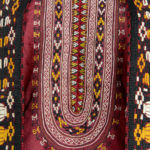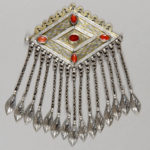The Turkmens. The art of everyday life
The collection
The Turkmen Collection of the Asia-Pacific Museum mainly includes traditional costumes and headgear, jewellery, decorative textiles, felts, carpets and contemporary art, represented by the work of Turkmen artists: Wlodzimierz Pawłocki and Meret Klychev. The collection was created thanks to items acquired in the field and donations by Andrzej Wawrzyniak, the founder and long-time director of the Museum as well as Inga Pawłocka’s numerous gifts, who contributed a representative set of Turkmen dresses to the collection.
Turkmens
The Turkmens are a Turkic ethnic group and, according to old beliefs, originate from one common ancestor – Oguza – who gave rise to several Turkmen groups. They live primarily in Turkmenistan, northern Afghanistan, Iran and eastern Turkey. Traditionally the Turkmens led and still lead a nomadic or semi-nomadic lifestyle based on animal herding or resided on the steppes, conditioned by their natural resources. Their simple lifestyle in the desert and steppe area has influenced the development of a rich material culture, whose most characteristic features are the carpeting, complicated embroidery and chunky carnelian jewellery.
Costume
Traditional Turkmen dress was sewn from narrow strips of silk in dominant shades of purple. The women’s costume consists of three parts: a long koynek dress with a richly embroidered neckline called a yaka, wide balak trousers with decorative embroidered hems and a chavyt gown. The distinctive outfits include the attire of married woman – the kurte and chyrpy – covering the head and the whole figure, with the sleeves flowing down alongside the back. They are richly embroidered in motifs of rams horns and the tree of life, symbolising success and fertility. A complementary element is the tahya (a low, embroidered headdress for young, unmarried women) and a gynach – tall decorated bonnets held with headscarfs, designed for married women. Once, the Turkmen women also wore chunky silver jewellery decorated with carnelian – today they are often imitations, as are the synthetics that replace silk. The men’s attire consists mostly of a white shirt, loose trousers and an overcoat – a chapan – tied with a silk waistband, and a tall sheepskin headdress called a telpek. Children’s costumes are still often decorated with amulets in the form of stitched coins and triangular pendants or appliqués.
Embroidery
Embroidery is present in everyday items of household use, in harness decorations (e.g. for camels) and as a distinctive decorative feature of costumes. A characteristic feature of Turkmen embroidery is a crocheted stitch called a kyezhdy, which young women learn for several years. Rich embroidery provides the setting for festive dresses of married women – the kurta and chypry. On everyday wear, it decorates the neckline of koynek dresses in the form of yaka stitching and the hem of women’s balak trousers. The headgear is also embroidered, especially the commonly worn low tahya caps. Among Turkmen embroidery the most characteristic of the Tekke groups that are distinguished by a consistent, codified colour scheme, based on red, black, yellow and white combinations. Dominant motifs include abstract, multiple zoomorphic patterns such as popular horned rams and vipers, plants – tulips and rosettes – as well as solar designs which, apart from their ornamental role, also have apotropaic power.
Carpets
The Turkmens are famous for the production of sheep-wool carpets, tied with a thick senneh knot and distinguished by meticulous execution. There are many types of carpets named after Turkmen tribes such as the Tekke, Yomut, Ersari, Salor and Chodor. The most distinctive and recognisable are the buchara type carpets, distinguished by parallel rows of geometric, polygonal floral gul on a purple background. Characteristic Turkmen carpet ware also includes prayer books with the geometric motifs of the mihrab, domestic ensi carpets that cover the entrances to homes, and germech that decorate the doorstep, chuval for carrying things and asmalyki – fabric that decorates the camel as it carries the bride during her wedding procession.
Felts
Among the Turkmen who lead a nomadic lifestyle, the tradition of making felt fabrics has survived to this day, made from sheep and camel wool, both practical and decorative. Characteristic products of this type include namad felt, decorating the yurt’s interior and covering its skeletal structure. Their composition consists of a central field, filled with repetitive stylised solar and animal motifs relating to the world of nature and of a border, filled with wavy trails.
Jewellery
Turkmen jewellery is distinguished by its extensive repertoire of silver ornaments with chunky, geometric forms. These include, among others, traditional sulsuleh forehead ornaments and chckeliki on the temples, elaborate ceremonial bukau neckalces, chunky bilezik bracelets, heart-shaped asyk ornaments and tumar amulets, as well as circular guliaka pendants and diamond-shaped changa worn on a daily basis. The decorations form symmetrical arrangements, engraved, openwork and gilded ornaments with strongly stylised vegetal and animal forms, such as ram’s horns. What distinguishes the decoration of Turkmen jewellery is the use of carnelian, a semi-precious stone. Its red colour symbolises vitality, fertility and happiness, and thus, in the hostile desert and steppe landscape, they acquire a particular significance. Traditional jewellery defined the status of women in the local community and provided protection for the entire family.
Curator: Karolina Krzywicka
Design and arrangement of the exhibition: Masakazu Miyanaga
Catalog design: Marta Przybył








![grafika z tekstem [journeys to the east]](https://www.muzeumazji.pl/maip/uploads/2022/08/baner_strona_english_tn-1140x220.jpg)








